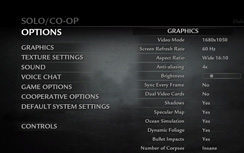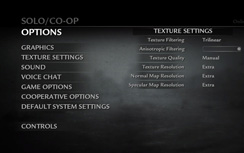Palit Revolution 700 (Radeon HD 4870 X2)
Written by Harry Butler
January 13, 2009 | 08:30
Tags: #4870 #4870-x2 #4870x2 #cooler #hd4870x2 #r700 #radeon #revolution #rv770 #testing #triple #triple-slot
Companies: #palit

Call of Duty: World at War
Publisher: ActivisionCall of Duty: World at War is Treyarch’s controversial World War II shooter set on the Pacific and Eastern fronts, where you switch roles between an American Marine and a Russian soldier who survives Stalingrad and follows the push into Berlin at the end of the war.
World at War uses a beefed up version of the proprietary engine used in Call of Duty 4: Modern Warfare, which was developed by Infinity Ward and has easily been the most successful game in the series. It uses the DirectX 9.0 renderer exclusively and features true world dynamic lighting, HDR lighting, dynamic shadowing and depth of field amongst other things.
We used the full retail version of the game downloaded from Steam, which was patched to version 1.1 and for our gameplay testing, we did a 90-second manual run through from the second mission in the game where you are part of a beach landing in the Pacific. It appears to be one of the more intensive parts of the game with lots of explosions, water, smoke and lighting effects thrown in for good measure.
All of the in-game settings were set to their maximum values, including texture details which were configured to 'Extra'. The 'Dual Video Cards' option was enabled for the multi-GPU configurations, but was disabled for all single GPU cards. Finally, anti-aliasing and anisotropic filtering were controlled from inside the game.
Call of Duty: World at War
1,680 x 1,050 4xAA 16xAF, DirectX 9, Maximum Detail
- Nvidia GeForce GTX 295 1,792MB
- ATI Radeon HD 4870 X2 2GB
- Palit Revolution 700 Radeon HD 4870 X2 2GB
- Nvidia GeForce GTX 280 1GB
- Nvidia GeForce GTX 260-216 896MB
- ATI Radeon HD 4870 512MB
- ATI Radeon HD 4870 1GB
-
-
88.9
-
70.0
-
-
-
74.7
-
20.0
-
-
-
74.1
-
20.0
-
-
-
62.3
-
48.0
-
-
-
57.0
-
42.0
-
-
-
48.2
-
36.0
-
-
-
47.9
-
33.0
-
0
10
20
30
40
50
60
70
80
90
Frames Per Second
-
Average
-
Minimum
Call of Duty: World at War
1,920 x 1,200 0xAA 16xAF, DirectX 9, Maximum Detail
- Nvidia GeForce GTX 295 1,792MB
- ATI Radeon HD 4870 X2 2GB
- Palit Revolution 700 Radeon HD 4870 X2 2GB
- Nvidia GeForce GTX 280 1GB
- Nvidia GeForce GTX 260-216 896MB
- ATI Radeon HD 4870 1GB
- ATI Radeon HD 4870 512MB
-
-
90.7
-
74.0
-
-
-
77.3
-
16.0
-
-
-
76.8
-
16.0
-
-
-
68.9
-
54.0
-
-
-
62.6
-
44.0
-
-
-
49.9
-
37.0
-
-
-
49.7
-
36.0
-
0
25
50
75
100
Frames Per Second
-
Average
-
Minimum
Call of Duty: World at War
1,920 x 1,200 4xAA 16xAF, DirectX 9, Maximum Detail
- Nvidia GeForce GTX 295 1,792MB
- ATI Radeon HD 4870 X2 2GB
- Palit Revolution 700 Radeon HD 4870 X2 2GB
- Nvidia GeForce GTX 280 1GB
- Nvidia GeForce GTX 260-216 896MB
- ATI Radeon HD 4870 1GB
- ATI Radeon HD 4870 512MB
-
-
83.0
-
59.0
-
-
-
65.0
-
16.0
-
-
-
64.9
-
17.0
-
-
-
55.1
-
38.0
-
-
-
49.3
-
34.0
-
-
-
40.7
-
28.0
-
-
-
40.5
-
29.0
-
0
10
20
30
40
50
60
70
80
90
Frames Per Second
-
Average
-
Minimum
Call of Duty: World at War
2,560 x 1,600 0xAA 16xAF, DirectX 9, Maximum Detail
- Nvidia GeForce GTX 295 1,792MB
- ATI Radeon HD 4870 X2 2GB
- Palit Revolution 700 Radeon HD 4870 X2 2GB
- Nvidia GeForce GTX 280 1GB
- Nvidia GeForce GTX 260-216 896MB
- ATI Radeon HD 4870 1GB
- ATI Radeon HD 4870 512MB
-
-
76.4
-
26.0
-
-
-
52.9
-
11.0
-
-
-
51.7
-
12.0
-
-
-
50.2
-
33.0
-
-
-
44.3
-
26.0
-
-
-
33.0
-
22.0
-
-
-
32.9
-
22.0
-
0
10
20
30
40
50
60
70
80
Frames Per Second
-
Average
-
Minimum
Call of Duty: World at War
2,560 x 1,600 2xAA 16xAF, DirectX 9, Maximum Detail
- Nvidia GeForce GTX 295 1,792MB
- Nvidia GeForce GTX 280 1GB
- Palit Revolution 700 Radeon HD 4870 X2 2GB
- ATI Radeon HD 4870 X2 2GB
- Nvidia GeForce GTX 260+ 216 896MB
- ATI Radeon HD 4870 1GB
- ATI Radeon HD 4870 512MB
-
-
71.6
-
25.0
-
-
-
46.9
-
31.0
-
-
-
45.9
-
11.0
-
-
-
45.3
-
9.0
-
-
-
39.1
-
25.0
-
-
-
28.2
-
20.0
-
-
-
27.4
-
19.0
-
0
10
20
30
40
50
60
70
Frames Per Second
-
Average
-
Minimum
Call of Duty: World at War
2,560 x 1,600 4xAA 16xAF, DirectX 9, Maximum Detail
- Nvidia GeForce GTX 295 1,792MB
- ATI Radeon HD 4870 X2 2GB
- Palit Revolution 700 Radeon HD 4870 X2 2GB
- Nvidia GeForce GTX 280 1GB
- Nvidia GeForce GTX 260-216 896MB
- ATI Radeon HD 4870 1GB
- ATI Radeon HD 4870 512MB
-
-
66.4
-
24.0
-
-
-
43.6
-
9.0
-
-
-
43.2
-
10.0
-
-
-
43.1
-
29.0
-
-
-
37.9
-
21.0
-
-
-
27.1
-
19.0
-
-
-
26.2
-
17.0
-
0
10
20
30
40
50
60
70
Frames Per Second
-
Average
-
Minimum
While the Call of Duty 4 engine has historically been very shader intensive, with the 9800GX2 a long recognised champion. The same core clock of the Revolution 700 once again does nothing to affect performance, with absolutely no significant impact on performance no matter what the resolution or anti aliasing setting used.











Want to comment? Please log in.